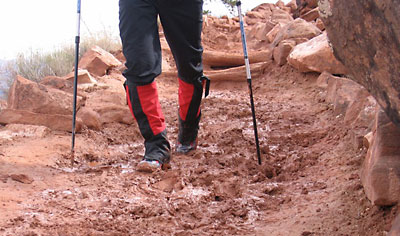What effect does a footstep have? The answer is, it depends. A footstep means different things to a tree sapling and meadow grass, to leaf litter and cryptobiotic soil, to a gravely riverbank and muddy springtime trail.
Unfortunately, trampling causes vegetation damage and soil erosion in virtually every environment. Recovery that takes a year in the southern Appalachians might require 25 years or more in Glacier National Park, Montana.
Other impacts are also possible. Most pristine soils contain animals that live or feed on decaying plants. Trampling destroys habitat for these insects, earthworms, mollusks and snails, as well as the fungi that fertilize the soil and help make regrowth possible. Vegetation protects underlying soils. Once plant growth is destroyed, erosion can continue with or without further use.
As the weather warms and the days get longer, the urge to hit the trail grows stronger every day. While springtime is a great time for hiking and trail running, it can also be a very sensitive time for the trails we enjoy.
Cycles of snow and sun and freeze and thaw can make for wet and muddy trail conditions in many parts of the country. In order to do the least possible damage to the trail, and to Leave No Trace, please keep the following in mind:
- Be prepared to hike or run down the middle of the trail even when wet or muddy. Stepping off the designated trail to avoid mud or standing water can quickly lead to the creation of undesignated trails, which can lead to even more erosion.
- Wear water-resistant or waterproof footwear. Even if you don’t have waterproof footwear, remember that shoes dry overnight while erosion can take years to recover.
- Consider wearing gaiters to help keep your feet dry. Gaiters, available at most any outdoor store, will help keep your feet dry when sticking to wet or muddy trails.
- Hike or run in the early morning or late afternoon. Muddy areas are more likely to be harder (due to colder air temps) and less messy since harder soils are much less likely to erode.
- When possible, stick to south-facing trails, which tend to be drier. The drier the trail, the less damage, if any.
- Consider using small sheet metal screws in the bottom of your soles. This will increase traction on icy areas, allowing you to stick to the trail in all conditions.
By following these simple recommendations, you’ll be more comfortable and more likely to hike or run right through the puddles and mud thereby causing no damage to trailside vegetation or unnecessary trail widening.
Enjoy the springtime and Leave No Trace.
Ben Lawhon is the education director for the Leave No Trace Center for Outdoor Ethics, one of the outdoor and environmental non-profit organizations that Trailspace supports.
Leave No Trace teaches people of all ages how to enjoy the outdoors responsibly, and is the most widely accepted outdoor ethics program used on public lands. As the leader in sustainable recreation practices, the center is training a nation of outdoor advocates to put Leave No Trace principles into action. www.LNT.org











